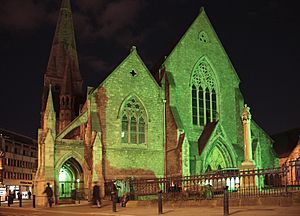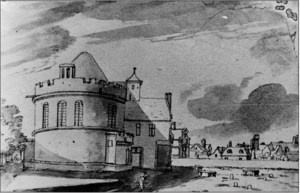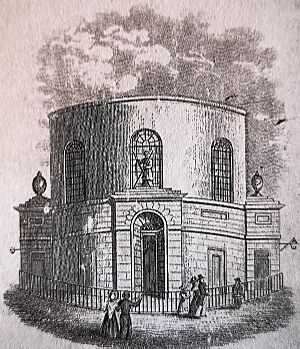St Andrew's Church, Dublin (Church of Ireland) facts for kids
Quick facts for kids St. Andrew's Church |
|
|---|---|

St Andrew's Church, from St Andrew's Street, in Dublin
|
|
| Location | Dublin |
| Country | Ireland |
| Denomination | Church of Ireland |
| History | |
| Founded | 16th century |
| Dedication | St. Andrew |
| Administration | |
| Parish | St. Andrew |
St Andrew's Church is a building in Dublin, Ireland, that used to be a church for the Church of Ireland. It is located on St Andrew's Street. After it stopped being a church, it became the main tourist office for Dublin, run by Fáilte Ireland, until 2014. Later, it was changed into a food hall.
A famous person named Vanessa (Esther Vanhomrigh), who was a student of Dean Swift, is buried at this church.
Contents
History of St Andrew's Church
The very first St Andrew's Church was on what is now Dame Street. This church disappeared around the mid-1600s during the time of Oliver Cromwell, a powerful leader in England.
The 1670 Church Building
A new church was built between 1670 and 1674. It was a bit further from the old city walls. This new church was built on an old bowling-green, which was near the Thingmote. The Thingmote was an important meeting place for the Norse (Viking) rulers of the city long ago.
The architect who designed this church was William Dodson. People said it had an unusual round or oval shape. You can see how it looked in a picture from 1698 by an artist named Francis Place.
Important people from the area, like Lord Anglesey and John Temple, helped manage the church at that time.
The Round Church Design
The church was largely rebuilt again between 1793 and 1807. This time, it was designed in the Georgian style. The main architect was Francis Johnston, who took over in 1800. The church opened its doors again in March 1807.
Because of its round shape, people often called it the "round church." It was said to be built in a similar style to the Santa Maria della Rotonda in Rome, Italy.
The Modern Gothic Church
Sadly, the church burned down in 1860. The building you see today, which has a Gothic style, was built in its place around 1862.
Important Burials and Memorials
Many people were buried or remembered at St Andrew's Church.
Inside the Church and Vaults
Some of the memorials inside the church include:
- Vanessa, who was a student of Jonathan Swift, was buried here in June 1723.
- Thomas Dalton, a very important judge in Ireland, was buried here in 1730.
- Marmaduke Coghill, who was a member of Parliament and a judge, was buried in his family's vault in this church in 1738.
In the Churchyard Cemetery
People buried in the churchyard (the area around the church) include:
- Alderman Thomas Pleasants, whose son Thomas Pleasants became a famous developer and helper of others. He was buried here in 1729.
- The surgeon Philip Woodroffe is also buried in the churchyard.
The Parish of St Andrew
The area that belonged to St Andrew's Church was the same as the civil parish of St Andrew. In 1901, about 3,058 people lived in this parish. By 1971, the population had decreased to about 300 people.




